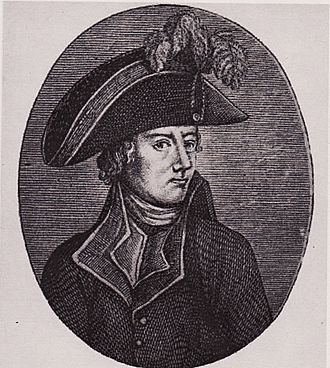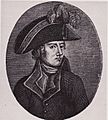Charles Armand Tuffin, marquis de la Rouërie facts for kids
Quick facts for kids
Armand Tuffin de La Rouërie
|
|
|---|---|

portrait by Charles Willson Peale
|
|
| Nickname(s) | Colonel Armand |
| Born | April 13, 1751 Fougères, Brittany, France |
| Died | January 30, 1793 (aged 41) Near Lamballe |
| Allegiance | |
| Service/ |
French Royal Army Continental Army French Royalists |
| Rank | Brigadier General |
| Commands held | Pulaski's Legion Armand's Legion Head of the Breton Association |
| Battles/wars | American Revolutionary War
|
| Awards | |
Charles Armand Tuffin, marquis de la Rouërie (born April 13, 1751 – died January 30, 1793) was a French cavalry officer. He was also known in the United States as "Colonel Armand." He fought for the Americans in the American Revolutionary War. After the Battle of Yorktown, he was promoted to brigadier general.
He is also known for starting and leading the Breton Association. This group was active during the French Revolution. La Rouërie is not as widely remembered as other French figures like Lafayette.
Contents
Early Life and Military Beginnings
Armand Tuffin de La Rouërie was born in Fougères, Brittany, France. From a young age, he was expected to have a military career. He had a very energetic personality. He served as an officer in the Gardes Françaises, which was a royal guard unit.
Fighting in the American Revolution
In January 1777, La Rouërie sailed from France to help the Americans. They were fighting for their independence from Britain. His ship, the Morris, was attacked by British ships in April. It sank in Chesapeake Bay, Delaware. La Rouërie managed to reach shore safely.
George Washington, the American commander, gave him orders. La Rouërie became known as Colonel Armand. He used his own money to recruit volunteers for his troops. His unit was first called Pulaski's Legion, named after its commander, Casimir Pulaski. After Pulaski died in 1779, it was renamed the First Partisan Corps, also known as Armand's Legion. This corps had both infantry (soldiers on foot) and cavalry (soldiers on horseback). It was made up of foreign volunteers and usually had three to five companies.
La Rouërie was promoted to a general on June 25, 1778. He fought in many important battles. These included Monmouth, Brandywine, and the Siege of Yorktown. In 1781, Colonel Armand went back to France. He needed to get new equipment for his troops. While there, he was made a Knight of the Order of Saint-Louis. On March 26, 1783, he became a brigadier general in the American Army. He left the American Army later that year, on November 25. He returned to France in the summer of 1784. He remained friends with George Washington and they continued to write letters to each other.
Role in the French Revolution
In the years leading up to the French Revolution, La Rouërie became a strong supporter of the nobility and parliament of Brittany. Brittany was a region in France. He felt they were losing their special rights to the central government in Versailles. In 1787, he was one of 12 representatives sent to the king. They asked for Brittany's old rights to be restored.
In 1788, he refused a military command from King Louis XVI. He did this because he disagreed with the king taking away liberties that Brittany had been promised. Because of this, he was put in the Bastille prison on July 14, 1788. He was freed a month later.
At first, La Rouërie welcomed the Revolution. However, at the Estates-General of 1789, he became upset. He saw that the nobles from Brittany were giving in to the demands of the common people. He encouraged them not to send representatives to the Estates General. He believed the old nobility should not give up their special status. This disagreement helped lead to the creation of the Breton Association.
Leading the Breton Association
La Rouërie traveled to Coblentz, a city outside France. There, he received special powers from French royal family members who had left France. He then began to organize the Breton Association. This group aimed to protect the traditional rights of Brittany. They gathered troops and worked to gain support.
La Rouërie found many supporters in Brittany. Many people there were unhappy with the results of the Revolution. They had first supported it, but then strongly opposed changes like the Civil Constitution of the Clergy. La Rouërie, though not a strict follower of the Catholic Church, criticized this new law. He wrote a statement for the Breton Association. He also argued that poverty had increased in Brittany. He said taxes were now three times higher since the region's old government was abolished.
On April 20, 1792, France declared war on Austria and the Holy Roman Empire. On the same day, opponents of the Revolution gained support from Prussia. This led to the formation of the first group of countries against Revolutionary France. The Breton Association was ready with 10,000 men prepared for battle.
After a raid on his castle, La Rouërie moved to Launay-Villiers. This place was near where Jean Chouan and his men were hiding. There is no clear proof that La Rouërie and Jean Chouan ever met. La Rouërie stayed at Launay-Villiers for three months.
His Final Days
In late 1792 and early 1793, La Rouërie traveled around the countryside of Brittany. He used a false name, Gasselin. He was only with his secretary, Loaisel Fricandeau, and a servant, Saint-Pierre. On January 12, 1793, they found shelter near Castle Guyomarch. This castle belonged to a family who were also part of the Breton Association. It had snowed that day, and Saint-Pierre was sick with a fever.
La Rouërie and his companions stayed at the castle for a few days. Saint-Pierre's health did not get better. A doctor was called. Saint-Pierre recovered, but then La Rouërie himself became ill on January 19. Doctors were called, and it was believed he had a fever with chills and a bad cough. Today, we know he had pneumonia.
On January 24, the National Guard from Lamballe raided Castle Guyomarch. La Rouërie was hidden in a nearby farm. The Guard found nothing. The next day, his partners brought a newspaper. It reported that King Louis XVI had been executed on January 21. They did not tell La Rouërie the news, hoping it would not make his fever worse.
However, La Rouërie asked to read the newspaper for news about the king's trial. He read the paper that had been left in the room. That is how he learned of King Louis XVI's death.
In a moment of confusion, La Rouërie tried to get out of bed and leave the castle. But he collapsed from weakness. For two or three days, he was very ill. He was sometimes weak, sometimes confused, and sometimes unconscious. A third doctor was called, but there was nothing more to be done. La Rouërie died on January 30, 1793, in the early morning.
Images for kids




